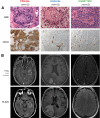Molecular Profiling Reclassifies Adult Astroblastoma into Known and Clinically Distinct Tumor Entities with Frequent Mitogen-Activated Protein Kinase Pathway Alterations
- PMID: 31346129
- PMCID: PMC6975955
- DOI: 10.1634/theoncologist.2019-0223
Molecular Profiling Reclassifies Adult Astroblastoma into Known and Clinically Distinct Tumor Entities with Frequent Mitogen-Activated Protein Kinase Pathway Alterations
Abstract
Background: Astroblastoma (ABM) is a rare glial brain tumor. Recurrent meningioma 1 (MN1) alterations have been recently identified in most pediatric cases. Adolescent and adult cases, however, remain molecularly poorly defined.
Materials and methods: We performed clinical and molecular characterization of a retrospective cohort of 14 adult and 1 adolescent ABM.
Results: Strikingly, we found that MN1 fusions are a rare event in this age group (1/15). Using methylation profiling and targeted sequencing, most cases were reclassified as either pleomorphic xanthoastrocytomas (PXA)-like or high-grade glioma (HGG)-like. PXA-like ABM show BRAF mutation (6/7 with V600E mutation and 1/7 with G466E mutation) and CD34 expression. Conversely, HGG-like ABM harbored specific alterations of diffuse midline glioma (2/5) or glioblastoma (GBM; 3/5). These latter patients showed an unfavorable clinical course with significantly shorter overall survival (p = .021). Mitogen-activated protein kinase pathway alterations (including FGFR fusion, BRAF and NF1 mutations) were present in 10 of 15 patients and overrepresented in the HGG-like group (3/5) compared with previously reported prevalence of these alterations in GBM and diffuse midline glioma.
Conclusion: We suggest that gliomas with astroblastic features include a variety of molecularly sharply defined entities. Adult ABM harboring molecular features of PXA and HGG should be reclassified. Central nervous system high-grade neuroepithelial tumors with MN1 alterations and histology of ABM appear to be uncommon in adults. Astroblastic morphology in adults should thus prompt thorough molecular investigation aiming at a clear histomolecular diagnosis and identifying actionable drug targets, especially in the mitogen-activated protein kinase pathway.
Implications for practice: Astroblastoma (ABM) remains a poorly defined and controversial entity. Although meningioma 1 alterations seem to define a large subset of pediatric cases, adult cases remain molecularly poorly defined. This comprehensive molecular characterization of 1 adolescent and 14 adult ABM revealed that adult ABM histology comprises several molecularly defined entities, which explains clinical diversity and identifies actionable targets. Namely, pleomorphic xanthoastrocytoma-like ABM cases show a favorable prognosis whereas high-grade glioma (glioblastoma and diffuse midline gliome)-like ABM show significantly worse clinical courses. These results call for in-depth molecular analysis of adult gliomas with astroblastic features for diagnostic and therapeutic purposes.
Keywords: Astroblastoma; BRAF mutation; MN1‐BEND2; Next‐generation sequencing.
© AlphaMed Press 2019.
Conflict of interest statement
Disclosures of potential conflicts of interest may be found at the end of this article.
Figures


References
-
- Louis DN, Perry A, Reifenberger G et al. The 2016 World Health Organization Classification of Tumors of the Central Nervous System: A summary. Acta Neuropathologica 2016;131:803–820. - PubMed
-
- Bailey P, Cushing H. Tumors of the Glioma Group. Philadelphia: Lippincott, 1924.
-
- Bailey P, Bucy PC. Astroblastomas of the brain. Acta Psychiatr Neurol 1930;5:439–461.
-
- Sughrue ME, Choi J, Rutkowski MJ et al. Clinical features and post‐surgical outcome of patients with astroblastoma. J Clin Neurosci 2011;18:750–754. - PubMed
-
- Mallick S, Benson R, Venkatesulu B. Patterns of care and survival outcomes in patients with astroblastoma: An individual patient data analysis of 152 cases. Childs Nerv Syst 2017;33:1295–1302. - PubMed
Publication types
MeSH terms
Substances
LinkOut - more resources
Full Text Sources
Medical
Research Materials
Miscellaneous

